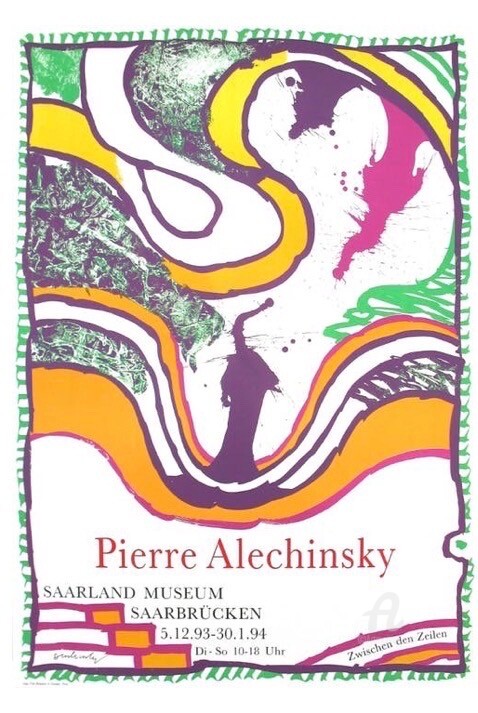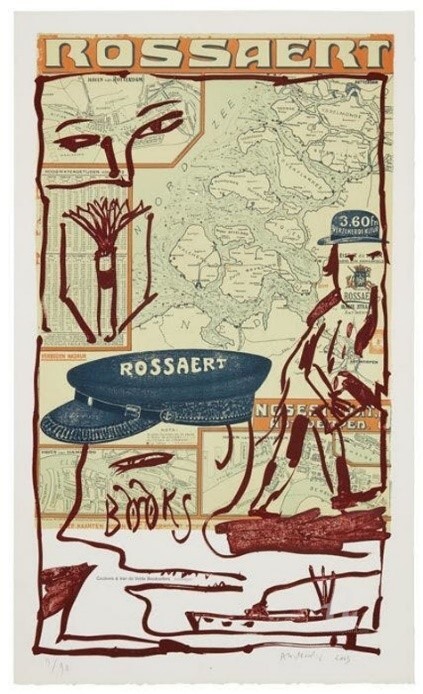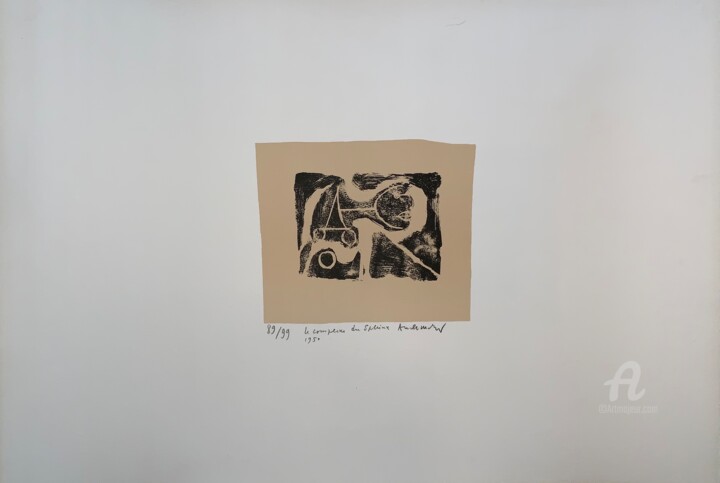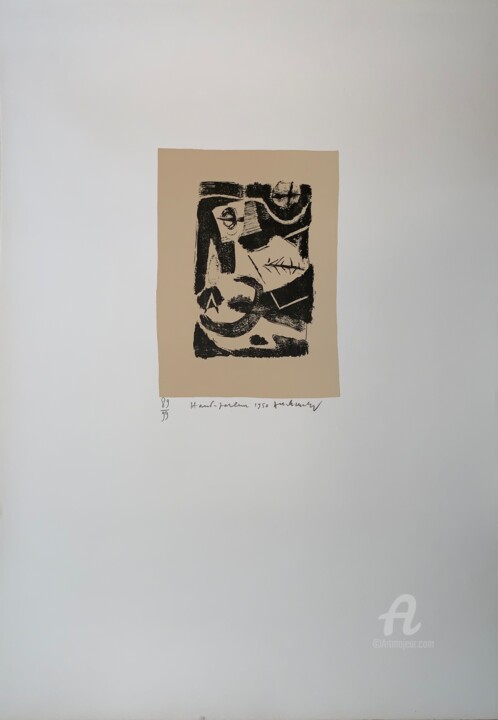Pierre Alechinsky is a distinguished Belgian master known for his dynamic and imaginative expressions. His production, characterized by a fusion of vibrant colors and calligraphic techniques, often delves into the realms of fantasy and the subconscious, making him a pivotal figure in contemporary creativity.
Biography of the Painter
Pierre Alechinsky (born October 19, 1927) is a Belgian master who has been residing and creating art in France since 1951. His style is associated with tachisme, abstract expressionism, and lyrical abstraction.
Alechinsky was born in Schaerbeek, Belgium, to a Russian Jewish father and a Belgian Walloon mother. In 1944, he enrolled at the École nationale supérieure d'Architecture et des Arts décoratifs de La Cambre in Brussels, where he studied illustration, printing, and photography. In 1945, he became acquainted with the productions of Henri Michaux and Jean Dubuffet and formed a friendship with critic Jacques Putman.
Style, Movement and Career
Pierre Alechinsky is associated with the CoBrA movement, which emphasized spontaneity, experimentation, and a child-like approach to creativity. His style is marked by the integration of Eastern calligraphic influences with Western abstract expressionism. Alechinsky's subjects often include fantastical creatures, non-figurative forms, and surreal landscapes, reflecting his fascination with the unconscious mind and the primal aspects of human nature.
In 1949, Pierre Alechinsky teamed up with Christian Dotremont, Karel Appel, Constant, Jan Nieuwenhuys, and Asger Jorn to establish the the above-mentioned group COBRA. He actively participated in latter exhibitions and, in 1951, went to Paris to study engraving at Atelier 17 under the mentorship of Stanley William Hayter.
By 1954, Alechinsky held his first exhibition in Paris and began exploring oriental calligraphy. In the early 1950s, he served as the Paris correspondent for the The Beauty of Ink, published by Morita Shiryu of the Bokujinkai group. In 1955, with the encouragement of Henri Storck and Luc de Heusch, Alechinsky traveled to Japan with his wife. There, he exhibited his production "Night, 1952" at the Ohara Museum in Kurashiki and created a film titled Japanese Calligraphy, with Christian Dotremont writing the commentary and André Souris composing the music.
By 1960, Alechinsky had showcased his production in London, Bern, and at the Venice Biennale, followed by exhibitions in Pittsburgh, in the Big Apple, Amsterdam, and Silkeborg, as his international acclaim grew.
He collaborated with Walasse Ting and maintained a close relationship with Christian Dotremont. He also developed connections with André Breton.
Throughout the 1970s, Alechinsky's international career flourished. By 1983, he had become a Professor of Painting in Paris. For the 2018/2019 season at the Vienna State Opera, Alechinsky designed the large-scale piece Loin d'ici (176 sqm) as part of the Safety Curtain exhibition series, conceived by museum in progress.
Awards
In 1994, Pierre Alechinsky received an honorary doctorate from the Free University of Brussels. The following year, one of his designs was featured on a Belgian postage stamp.
Collections
Alechinsky's pieces are part of numerous prestigious collections, including the Royal Institution of Belgium, the Tate, Museum Ludwig in Cologne, the Big Apple Institution of Modern Art, the Walker Center in Minneapolis, the Institution of Southeast Texas in Beaumont, Texas, the Institution of Art Fort Lauderdale at Nova Southeastern University in Fort Lauderdale, Florida, and the Fisogni Institution in Tradate, Italy. Additionally, in October 2000, the main-belt asteroid 14832 Alechinsky was named in his honor.
Famous Artworks
Among Pierre Alechinsky's most renowned pieces are:
"Central Park" (1965): This vibrant depiction of New York's Central Park blends abstract forms with recognizable urban elements. Created during his stay in Manhattan, the work uses acrylic paint combined with ink drawings in the margins, marking a turning point in Alechinsky's style.
"Horizon" (1959): This piece is a significant example of Alechinsky's calligraphic technique, showcasing his ability to seamlessly merge line and color. Although specific detailed descriptions of "Horizon" were not found in recent sources, it is known that works from this period reflect his mastery in combining Eastern and Western techniques.
 Zwischen Den Zeilen. (1994) Printmaking by Pierre Alechinsky
Zwischen Den Zeilen. (1994) Printmaking by Pierre Alechinsky
Analysis of some pieces
"Zwischen Den Zeilen" (1994)
Zwischen Den Zeilen (1994) is a captivating printmaking piece. This work exemplifies Alechinsky's distinctive style, characterized by dynamic lines, bold colors, and a fusion of abstract and figurative elements.
In this print, Alechinsky employs a vibrant palette dominated by green, yellow, and magenta hues, creating a lively and engaging composition. The title, which translates to "Between the Lines," hints at the thematic exploration of the space and meaning that exists beyond the visible.
The central figure, rendered in a semi-abstract form, appears to be surrounded by swirling, organic shapes that evoke a sense of movement and fluidity. This interplay between the figure and the surrounding shapes creates a visual rhythm that draws the viewer's eye across the entire piece.
The use of bold, contrasting colors and the integration of spontaneous, calligraphic lines reflect Alechinsky's background in the CoBrA movement, known for its emphasis on expressionism and experimentation. The print's layered composition invites viewers to look deeper, discovering hidden details and meanings "between the lines."
Overall, "Zwischen Den Zeilen" is a testament to Alechinsky's ability to blend abstraction with recognizable forms, encouraging viewers to engage with the piece on multiple levels and interpret its intricate layers of meaning.
 Motus Vivendi (2008) Printmaking by Pierre Alechinsky
Motus Vivendi (2008) Printmaking by Pierre Alechinsky
"Motus Vivendi" (2008)
Motus Vivendi (2008) is a compelling printmaking masterpiece. This piece, created using etching on paper, is part of a limited edition of 90 copies, reflecting Alechinsky's characteristic style that blends abstract forms with calligraphic elements.
In "Motus Vivendi," Alechinsky employs a restrained color palette dominated by blue, brown, and red hues. The central focus of the piece is the phrase "Motus Vivendi," inscribed in bold red letters within an abstract, mountain-like shape. This phrase, which translates to "way of living" or "manner of living," invites contemplation on the harmony and balance in life.
The surrounding lines and shapes create a sense of movement and flow, reminiscent of Alechinsky's signature calligraphic strokes. The use of blue in the background suggests a serene, almost aquatic environment, while the brown adds a grounding, earthy contrast. The abstract nature of the shapes and lines encourages viewers to interpret the piece in multiple ways, exploring themes of coexistence, adaptation, and balance.
The detailed etching technique highlights Alechinsky's skill in printmaking, allowing for intricate textures and depth within the piece. The border, with its jagged, almost stitched appearance, frames the central image, adding a tactile quality that enhances the visual experience.
Overall, "Motus Vivendi" is a testament to Alechinsky's ability to merge text and image seamlessly, creating a piece that is both thought-provoking and visually engaging. This masterpiece reflects his ongoing exploration of the interplay between word and form, inviting viewers to find meaning within the abstract and the symbolic.
 Haut Parleur (1950) Printmaking by Pierre Alechinsky
Haut Parleur (1950) Printmaking by Pierre Alechinsky
"Haut Parleur" (1950)
Haut Parleur (1950) is a notable printmaking. This lithograph, part of a limited edition of 90 copies, showcases Alechinsky's early experimentation with abstract forms and his distinctive use of monochromatic tones.
In "Haut Parleur," Alechinsky employs a stark black ink on beige paper, creating a powerful contrast that highlights the intricate details and textures of the piece. The title, which translates to "Loudspeaker," hints at the communicative and expressive nature of the piece. The composition features a series of abstract shapes and symbols, arranged in a way that suggests movement and dynamism.
The central motif appears to be an amalgamation of geometric forms and organic lines, which together evoke a sense of sound waves or vocal expression. This visual representation aligns with the title, suggesting the transmission of ideas and emotions through creativity. The use of lithography allows for rich, varied textures, giving the piece depth and complexity.
Alechinsky's characteristic spontaneity and fluidity are evident in the free-flowing lines and the loose, almost calligraphic strokes that define the forms within the composition. This early piece reflects his involvement with the movement above mentioned, known for its emphasis on artistic freedom and the rejection of traditional techniques.
Overall, "Haut Parleur" is a compelling example of Alechinsky's ability to convey abstract concepts through his innovative use of form and medium. The piece invites viewers to engage with the visual language of abstraction, interpreting the layered meanings and emotions embedded within the lines and shapes. This lithograph not only showcases Alechinsky's technical skill but also his deep engagement with the themes of communication and expression.
Exhibitions and the Art Market
Pierre Alechinsky's pieces have been featured in numerous prestigious exhibitions worldwide, including the Museum of Modern Art in New York, the Centre Pompidou in Paris, and the Royal Museums of Belgium. His art remains highly sought after in the market, with pieces fetching substantial prices at major auction houses like Sotheby's and Christie's.
Artists Inspired by Alechinsky
Alechinsky's innovative approach could have inspired many contemporary creatives. His use of color, form, and spontaneous expression might have influenced figures like Karel Appel, Asger Jorn, and even later masters such as Jean-Michel Basquiat, who might have admired Alechinsky's ability to blend abstract expressionism with figurative elements.
Little-Known Facts
- Oriental Influence: Alechinsky's time in orient significantly impacted his style, particularly his use of calligraphy and paper.
- Literary Connections: He has collaborated with numerous writers and poets, creating illustrated books that blend visual art with literature.
Pierre Alechinsky stands out as a transformative figure in modern creativity, blending Eastern and Western techniques to create a unique and influential style. His production continues to inspire and challenge, making him a crucial figure in the creative world. From his early days with CoBrA to his enduring influence on contemporary masters, Alechinsky's contributions to art are both profound and lasting.


 Selena Mattei
Selena Mattei





